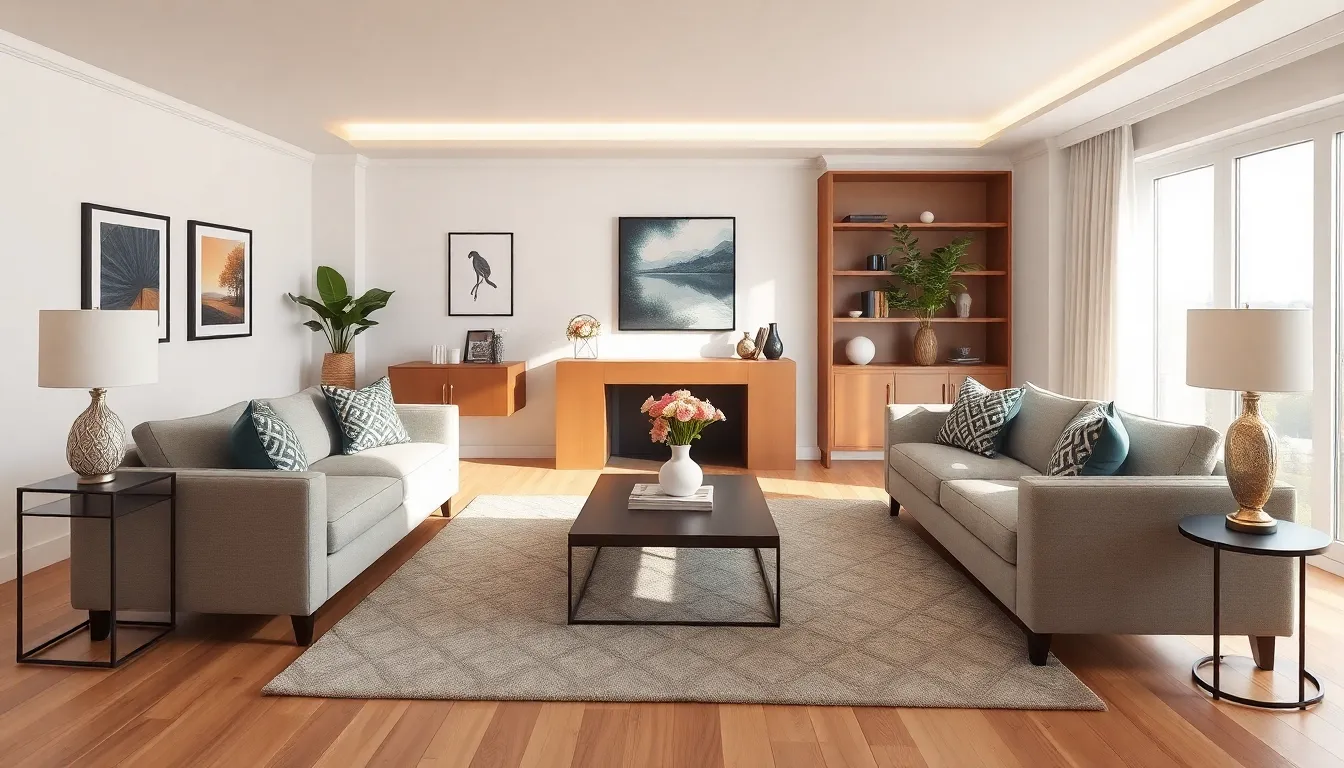Finding balance in interiors is like walking a tightrope—one wrong move and your space could tip from chic to chaotic. It’s not just about throwing a few cushions on a couch and calling it a day. True harmony involves a delightful dance of colors, textures, and shapes that work together to create a space that feels just right.
Table of Contents
ToggleUnderstanding Balance in Interiors
Balance in interiors refers to the distribution of visual weight within a space. Achieving this element requires a keen awareness of how various design components work together.
Definition of Balance
Balance in interior design encompasses three main types: symmetrical, asymmetrical, and radial. Symmetrical balance relies on equal distribution of visual weights, creating a mirrored effect. Asymmetrical balance involves different elements that still achieve equilibrium, offering a more dynamic yet harmonious feel. Radial balance arranges elements around a central point, drawing the eye inward. Each type plays a crucial role in establishing visual stability, ensuring that viewers feel at ease within the space.
Importance of Balance in Design
Balance holds critical importance in design as it influences the overall aesthetic and functionality of a space. It enhances comfort, ensuring spaces feel inviting and cohesive. A well-balanced room directs attention, guiding the eye to various focal points. When balance isn’t achieved, chaos often ensues, disrupting the visual flow. Furthermore, harmonious spaces promote positive moods, affecting occupants’ well-being. Designers often use balance to shape perceptions, showcasing how practical and appealing interiors can coexist seamlessly.
Types of Balance in Interior Design

Achieving balance in interior design involves understanding different types of balance: symmetrical, asymmetrical, and radial. Each type plays a significant role in creating harmonious and inviting spaces.
Symmetrical Balance
Symmetrical balance relies on creating a mirrored effect in design. Elements on either side of a central axis match in form, size, and color. Designers often achieve this through furniture placement, artwork, and décor, resulting in a sense of calm and order. Living rooms commonly use symmetrical arrangements, where matching sofas or chairs frame a coffee table. Designers frequently utilize this technique for formal spaces, as it enhances predictability and organization.
Asymmetrical Balance
Asymmetrical balance offers a dynamic approach to interior design. This type of balance occurs when different elements create an overall sense of equilibrium. Designers pair items of differing sizes, colors, or shapes to achieve this effect. A large piece of artwork may hang above a smaller console table, balancing visual weight through contrast. Asymmetrical balance works well in casual environments like family rooms, promoting a lively, approachable atmosphere.
Radial Balance
Radial balance organizes elements around a central point, creating a circular flow. This design technique often appears in spaces featuring round tables, light fixtures, or architectural features. Elements radiate outward from the center, guiding the eye toward focal points. Dining rooms frequently showcase radial balance through table arrangements, while sunburst mirrors exemplify this technique. By directing attention outward, radial balance fosters a cohesive, inviting space.
Techniques to Achieve Balance
Achieving balance in interiors involves various techniques that enhance visual harmony. Implementing these strategies cultivates a cohesive atmosphere.
Color Balance
Consider the impact of color in creating balance. Neutral tones may provide a calm backdrop, allowing bolder hues to serve as accents. By distributing colors evenly across a space, visual weight remains consistent. Fluctuating between warm and cool shades can invigorate a room without overwhelming it. Use harmonious palettes that complement each other to ensure a seamless transition. In addition, contrasting colors can highlight specific areas, adding vibrancy without sacrificing equilibrium.
Scale and Proportion
Scale and proportion play vital roles in achieving balance. Larger furniture pieces can anchor a room, providing a foundation for smaller items. Positioning these larger elements thoughtfully creates an illusion of spaciousness. Beyond size, proportion refers to the relationship between objects. Ensuring that the height and width of furnishings work together promotes a sense of harmony. Mixing various sizes can inject interest into the design, as long as overall coherence remains intact.
Texture and Material Balance
Texture and material add depth to interiors and contribute to balance. Mixing soft fabrics with hard surfaces creates an engaging contrast. For example, pairing plush sofas with sleek metal tables maintains interest without excess clutter. Introducing a variety of textures enhances tactile appeal, inviting interaction. Natural materials can ground a space, while synthetic options might introduce modern flair. Strive for a balance between different textures to achieve a well-rounded environment that feels inviting and comfortable.
The Role of Balance in Creating Mood
Balance in interior design significantly affects the overall mood and atmosphere of a space. Visual weight distribution contributes to a sense of stability, helping occupants feel more at ease.
Enhancing Comfort
Comfort emerges from a well-balanced interior. Soft textures paired with sturdy furniture create an inviting environment. Distributing colors thoughtfully fosters relaxation, while symmetrical arrangements can evoke feelings of security. Natural light further enhances comfort by illuminating the space evenly. A cohesive design encourages individuals to unwind and enjoy their surroundings.
Promoting Functionality
Functionality relies on balance as well. Well-placed furniture improves traffic flow, minimizing obstacles that can disrupt daily activities. Each element should serve a purpose, ensuring that aesthetics don’t compromise usability. Asymmetrical designs can promote openness, encouraging interaction within the space. Maintaining an organized layout facilitates efficiency, allowing occupants to focus on tasks without distraction.
Achieving balance in interior design is essential for creating spaces that are both functional and aesthetically pleasing. By thoughtfully combining colors textures and shapes designers can cultivate environments that evoke comfort and harmony. Whether opting for symmetrical asymmetrical or radial balance each approach offers unique benefits that cater to different styles and preferences.
The interplay of visual weight distribution not only enhances the overall look but also influences the mood of a space. A well-balanced interior fosters relaxation and promotes positive interactions among occupants. Ultimately balance isn’t just a design principle; it’s a foundation for creating inviting spaces that resonate with both beauty and practicality.




